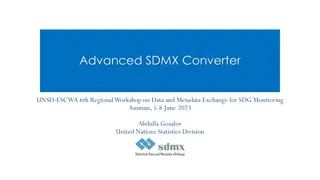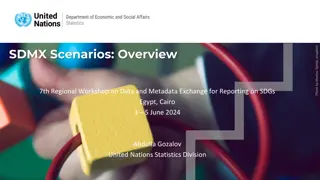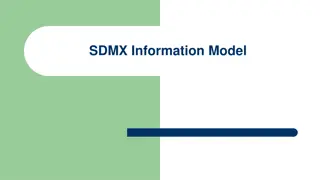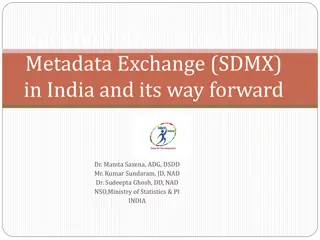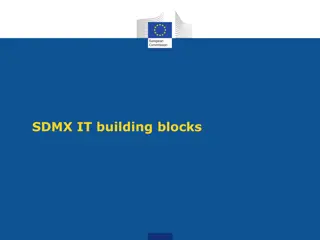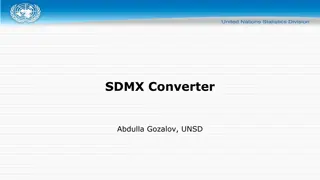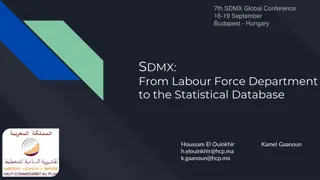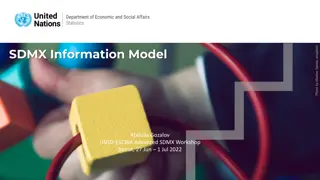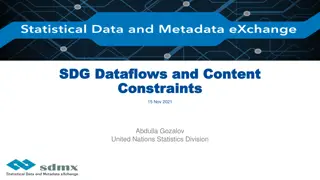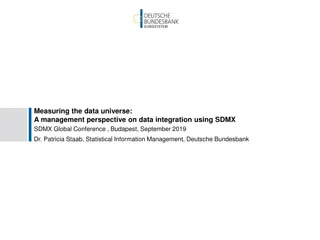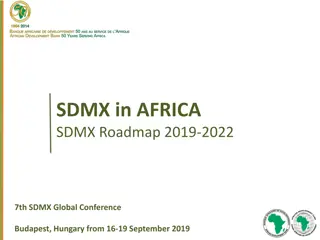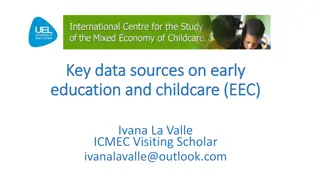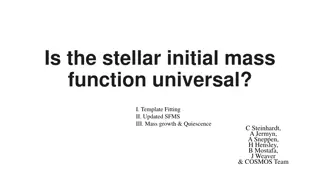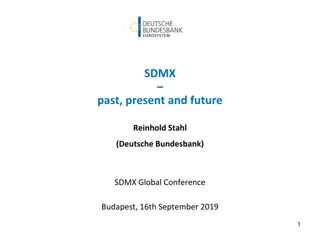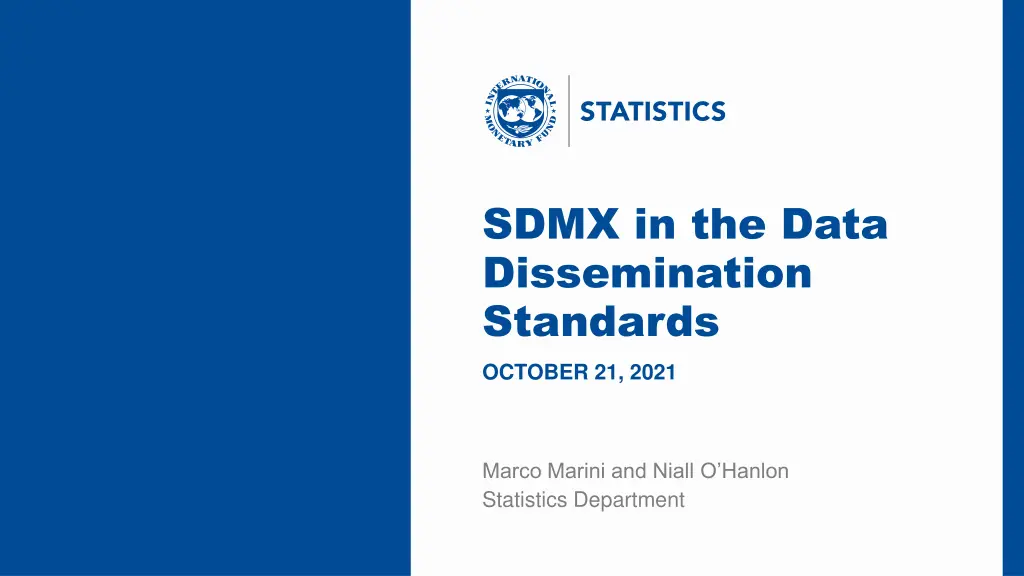
Understanding SDMX Data Dissemination Standards
Discover the IMF's Data Dissemination Standards, including the various tiers and benefits. Learn about National Data Summary Pages, SDMX technology, and the importance of standardized IT tools for statistical data exchange.
Download Presentation

Please find below an Image/Link to download the presentation.
The content on the website is provided AS IS for your information and personal use only. It may not be sold, licensed, or shared on other websites without obtaining consent from the author. If you encounter any issues during the download, it is possible that the publisher has removed the file from their server.
You are allowed to download the files provided on this website for personal or commercial use, subject to the condition that they are used lawfully. All files are the property of their respective owners.
The content on the website is provided AS IS for your information and personal use only. It may not be sold, licensed, or shared on other websites without obtaining consent from the author.
E N D
Presentation Transcript
SDMX in the Data Dissemination Standards OCTOBER 21, 2021 Marco Marini and Niall O Hanlon Statistics Department IMF IMF | Statistics 1
IMF Data Dissemination Standards IMF Data Dissemination Standards Developed to: Enhance the availability of macroeconomic and financial statistics through dissemination of data on National Summary Data Pages Promote the development of transparent and sound statistical systems Three tiers with progression encouraged: Enhanced General Dissemination Standard (e-GDDS 2015 SDMX) Special Dissemination Standard (SDDS 1996) Special Dissemination Standard Plus (SDDS Plus 2012 SDMX) The Eurasian Economic Union (EAEA) economies all became SDDS adherents between 2003 and 2005 IMF IMF | Statistics 2
National National Data Summary Page Data Summary Page SDMX SDMX Hub for key indicators Easy access to SDMX data, link to national dissemination, metadata Via national websites or IMF Dissemination Standards Bulletin Board (DSBB) IMF IMF | Statistics 3
National Data Summary Page HTML National Data Summary Page HTML Similar layout Via national websites or IMF Dissemination Standards Bulletin Board (DSBB) Access to current and previous period data only, link to national dissemination but . No access to longer time series or metadata HTML also less efficient for uploader and users IMF IMF | Statistics 4
SDMX SDMX SDMX stands for: Statistical Data and Metadata eXchange It comprises a: Model to describe statistical data and metadata Standard for automated communication from machine to machine Technology supporting standardized IT tools IMF IMF | Statistics 5
The Sponsors of SDMX The Sponsors of SDMX IMF IMF | Statistics 6
SDMX Dissemination SDMX Dissemination Standard Content Format for for Content Delivery Standard Format Production Standard Output Standard Input Machine to Machine Processes IMF IMF | Statistics 7
Standardize and Streamline using SDMX Standardize and Streamline using SDMX Data exchange processes use standard protocols (web services) Data content is defined using common dimensions and descriptions The common data model makes it easier to communicate about the data model between and within organizations Countries disseminate once using SDMX standards and multiple organizations can retrieve the data IT tools developed for SDMX standards can be more easily shared and reused IMF IMF | Statistics 8
Automate using SDMX Automate using SDMX Automation of exchange Web services use standard protocols making it straight forward to develop data exchange tools Automation of statistical processes SDMX enables the development of common tools that can be used by all statistical organizations to improve their activities IMF IMF | Statistics 9
SDMX Benefits the Compiler and User SDMX Benefits the Compiler and User For the compiler Widely adopted and used within official statistics Supported by international agencies Fosters collaboration For the user Transparency common data structure definitions Repeatable across domains, countries, and over time Scalable number and length of timeseries Enhanced reliability with monitoring IMF IMF | Statistics 10
Half of IMF Member Economies have SDMX Half of IMF Member Economies have SDMX enabled NSDPs in 2021 enabled NSDPs in 2021 Excellent assessment of two data sources (DLS and CBC datasets) Datasets differ with respect to information detail and market coverage. Significant work on data preparation has already been done. Clear procedure exists to update missing entries in DLS dataset with CBC entries where possible. Development of a merged dataset completed. Analytical indices compiled For 10 different strata of the Cypriot residential property market Using Average Characteristics method Sound method for variable selection exists. Good method for outlier detection is already implemented (based on Cook s distance). The team has already programmed multiple R-codes for data analysis and index computation. Transaction prices have been highlighted as the target variable for a new RPPI Less lag in indicating market turning points DLS transaction prices have been investigated and found to be timely and of good quality. Data sharing and engagement with IMF team IMF IMF | Statistics 11
Initiatives to Assist SDDS Adherents to Adopt Initiatives to Assist SDDS Adherents to Adopt SDMX SDMX So far by request Compilers wishing to benefit from efficiencies Argentina, Mongolia, Saudi Arabia and Senegal have adopted SDMX within the SDDS standard Currently working with a number of SDDS countries Larger-scale initiative to assist SDDS adherents to adopt SDMX on the horizon Each of the EAEU countries continue to use .HTML based pages A regional approach to assisting countries might bring benefits of shared learning and a regional community of practice Very successful partnership with AfDB more than 30 e-GDDS NSDPs using SDMX IMF IMF | Statistics 12
IMF Bilateral Support to Compilers IMF Bilateral Support to Compilers Technical assistance Capacity building for SDMX usage Build, maintain, and refresh knowledge of dissemination techniques SDMX Central Web services to create and read XML files Data Structure Definitions ECOFIN is a single DSD for reporting NSDP components across domains Support for development and maintenance of internationally agreed (Global) codelists IMF IMF | Statistics 13
THANK YOU THANK YOU Questions? MMarini@IMF.ORG NOHanlon@imf.org IMF IMF | Statistics 14



